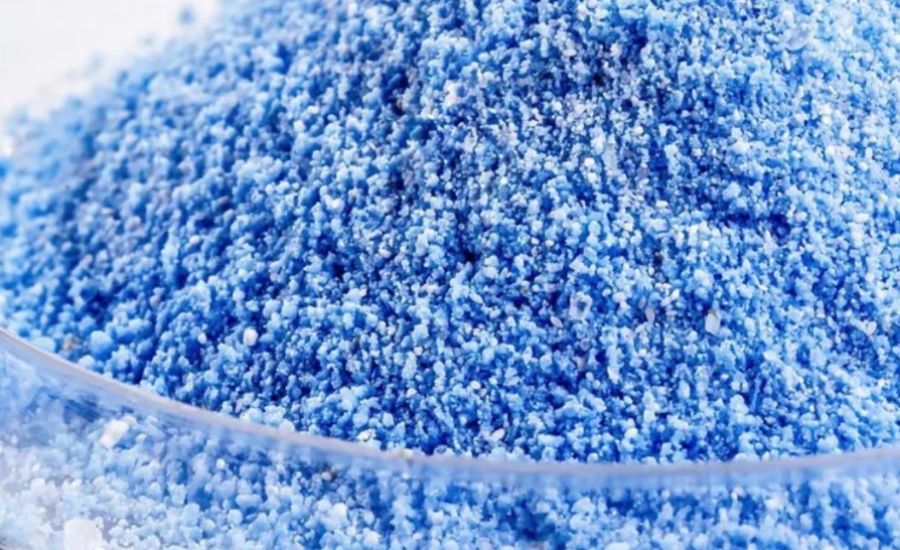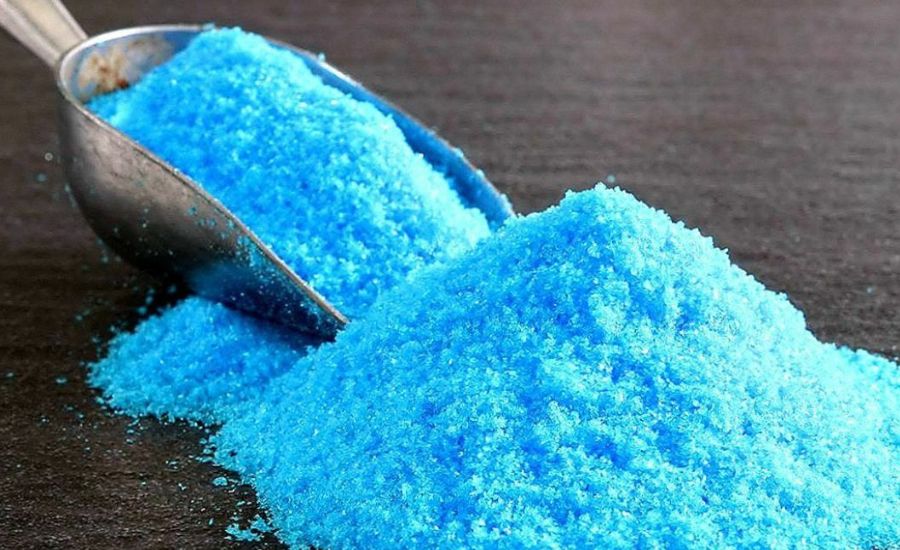Can You Use Copper Sulfate Pentahydrate For Ellmans Condensation, Properties & More
Introduction To Can You Use Copper Sulfate Pentahydrate For Ellmans Condensation
Ellman’s Condensation is a widely used reaction in organic chemistry, playing a crucial role in the formation of β-dicarbonyl compounds. These compounds serve as valuable intermediates in a variety of chemical syntheses, particularly in the creation of complex molecules for pharmaceuticals, agrochemicals, and other industries. The reaction typically involves the condensation of an aldehyde or ketone with a thiol, facilitated by a suitable catalyst. One compound that has gained attention for its potential application in Ellman’s Condensation is copper sulfate pentahydrate, a versatile inorganic salt that can act as a catalyst in this reaction.
Copper sulfate pentahydrate, commonly recognized for its role in agriculture and as a fungicide, has also found use in various chemical reactions, including organic synthesis. In the context of Ellman’s Condensation, copper sulfate pentahydrate provides a cost-effective and environmentally friendly alternative to traditional catalysts. The catalyst works by coordinating with the reactants, helping to stabilize the transition state and accelerating the reaction rate. This makes it a suitable choice for chemists looking for an efficient, green approach to synthesis.
When used in Ellman’s Condensation, copper sulfate pentahydrate has several advantages. First, it is relatively easy to handle and is soluble in water, making it convenient for aqueous reaction conditions. Second, copper ions can help to promote the activation of the thiol group, facilitating the formation of the β-dicarbonyl compound. Additionally, the reaction is typically milder when copper sulfate pentahydrate is used, reducing the likelihood of side reactions or degradation of sensitive reactants.
However, there are some considerations to keep in mind when utilizing copper sulfate pentahydrate in Ellman’s Condensation. The reaction conditions, such as temperature and pH, must be carefully optimized to achieve the desired results. While copper sulfate pentahydrate is an effective catalyst, it may not be as reactive as other more specialized catalysts, and the reaction may require longer times or higher concentrations of the catalyst to achieve full conversion.
In conclusion, copper sulfate pentahydrate can indeed be used effectively in Ellman’s Condensation, offering an accessible and sustainable option for synthesizing β-dicarbonyl compounds. By carefully controlling the reaction conditions and optimizing the catalyst concentration, chemists can harness the full potential of this versatile catalyst in organic synthesis. This approach reflects the ongoing trend in modern chemistry toward more environmentally conscious and cost-effective synthetic methods. In this article we;ll read about Can You Use Copper Sulfate Pentahydrate For Ellmans Condensation.
What is Ellman’s Condensation?

Ellman’s condensation is a properly-mounted response in organic chemistry, commonly employed to synthesize β-dicarbonyl compounds, along with β-diketones or β-ketoesters.In the presence of a base, this reaction involves the condensation of an aldehyde or ketone with an energetic methylene molecule, such as a β-diketone or β-ketoester. The final results is the formation of a β-diketone or β-ketoester, compounds that serve as important intermediates inside the synthesis of more complicated molecules with valuable functional corporations.
Copper Sulfate Pentahydrate: An Introduction
Copper sulfate pentahydrate (CuSO₄·5H₂O) is a blue crystalline compound this is broadly used in chemical packages. Known for its capacity to function a catalyst, reagent, and source of copper ions, copper sulfate pentahydrate is a flexible compound in artificial chemistry. This phase explores its ability role in Ellman’s condensation, in particular its catalytic residences.
Properties of Copper Sulfate Pentahydrate:
Appearance: Blue crystalline stable
Solubility: Highly soluble in water
Common Applications: Fungicide, algicide, and catalyst in various chemical reactions
Copper Sulfate Pentahydrate in Ellman’s Condensation
In Ellman’s condensation, copper sulfate pentahydrate can act as a catalyst to accelerate the reaction. Its primary function is to facilitate the activation of the carbonyl group inside the aldehyde or ketone, which will increase its reactivity towards the β-diketone or β-ketoester. By doing so, copper sulfate pentahydrate aids inside the formation of the preferred β-dicarbonyl product.
Mechanism of Action:
Coordination: Copper ions from copper sulfate pentahydrate engage with the carbonyl oxygen of the aldehyde or ketone. This interplay boosts the electrophilicity of the carbonyl carbon, making it extra.
Formation of Intermediate: The enhanced electrophilic character of the carbonyl carbon allows the β-diketone or β-ketoester to attack it, creating a tetrahedral intermediate.
Deprotonation and Final Product: The intermediate collapses, leading to the formation of the β-dicarbonyl compound, with the copper catalyst being regenerated in the process.
Experimental Procedure

Materials:
Copper sulfate pentahydrate
Aldehyde or ketone
β-Diketone or β-ketoester
Base (e.g., sodium ethoxide or potassium carbonate)
Solvent (e.g., ethanol or dimethylformamide, DMF)
Procedure:
Copper Solution Preparation: Dissolve copper sulfate pentahydrate in water to prepare a solution containing copper ions.
Reactant Mixing: In an appropriate solvent, combine the aldehyde or ketone with the β-diketone or β-ketoester.
Base Addition: Gradually introduce the base to the mixture, initiating the condensation reaction. The base deprotonates the β-diketone, making it more nucleophilic and thus more reactive in the reaction.
Reaction Monitoring: Track the reaction progress using Thin Layer Chromatography (TLC) or other suitable techniques.
Product Isolation: Once the reaction has completed, isolate the final product using standard methods, such as filtration or extraction. Purify the product as necessary.
In summary, copper sulfate pentahydrate is an effective catalyst in Ellman’s condensation, enhancing the formation of β-dicarbonyl compounds. Its application not only promotes efficient synthesis but also contributes to the development of green and sustainable chemistry, offering an environmentally friendly option for researchers involved in organic synthesis
Advantages of Using Copper Sulfate Pentahydrate
Copper sulfate pentahydrate (CuSO₄·5H₂O) is increasingly identified for its capacity to beautify the performance of organic reactions, consisting of Ellman’s condensation, a reaction used to synthesize β-dicarbonyl compounds. This compound now not handiest accelerates reactions however also improves yields and allows achieve the preferred product under milder conditions compared to standard catalysts. Below, we discover how copper sulfate pentahydrate contributes to more green chemical syntheses and the concerns that want to be taken into account whilst using it.
Benefits of Copper Sulfate Pentahydrate in Ellman’s Condensation
Faster Reaction Times: Copper sulfate pentahydrate has been shown to boom the rate of the Ellman’s condensation response. This acceleration can shorten reaction instances, offering a extra efficient process.
Higher Yields: The catalyst works by way of enhancing the coordination and activation of the carbonyl agencies in aldehydes and ketones. This often results in progressed yields of the β-dicarbonyl merchandise.
Milder Reaction Conditions: Unlike different catalysts that may require harsher conditions, copper sulfate pentahydrate helps the response beneath milder conditions. This not only prevents capability facet reactions however also facilitates make the procedure more sustainable and more secure.
Important Considerations and Safety Measures

Catalyst Loading: It is critical to optimize the amount of copper sulfate pentahydrate used in the response. If an excessive amount of is used, unwanted facet reactions may additionally occur. Conversely, the use of too little might also bring about inadequate activation of the carbonyl groups, hindering the response’s efficiency.
Solvent Selection: A suitable solvent must be chosen to make sure that each the reactants and the copper sulfate pentahydrate dissolve well. This is critical for attaining the desired reaction charge and efficiency.
Safety Precautions: Copper sulfate pentahydrate is toxic if ingested or inhaled. Therefore, it’s vital to handle the compound with care, carrying suitable private protecting equipment (PPE), together with gloves and goggles, and conducting the response in a well-ventilated place to minimize exposure.
Case Study: Copper Sulfate Pentahydrate in Ellman’s Condensation
Objective:
The goal of this study was to assess the effectiveness of copper sulfate pentahydrate as a catalyst in Ellman’s condensation, evaluating its performance to traditional techniques.
Background:
Ellman’s condensation includes the reaction of an aldehyde or ketone with a β-diketone or β-ketoester inside the presence of a base. Traditionally, bases like sodium ethoxide or potassium carbonate are used. However, the introduction of a steel catalyst, including copper sulfate pentahydrate, has proven promise in enhancing each response performance and product yield.
Materials and Methods:
Reactants: Benzaldehyde, acetylacetone (β-diketone)
Catalyst: Copper sulfate pentahydrate
Base: Sodium ethoxide
Solvent: Ethanol
Procedure:
Prepare a 0.1 M copper sulfate pentahydrate solution in water.
Mix benzaldehyde and acetylacetone in ethanol.
Add the copper sulfate pentahydrate solution to the reaction mixture.
Gradually introduce sodium ethoxide to initiate the condensation reaction.
Monitor the reaction progress via Thin Layer Chromatography (TLC).
Isolate and purify the product through filtration and recrystallization.
Results:
Reaction Time: The reaction time was reduced by approximately 30% when copper sulfate pentahydrate was used compared to the traditional method with sodium ethoxide alone.
Yield: The yield of the β-dicarbonyl compound increased by 20% when copper sulfate pentahydrate was used.
Purity: The product achieved with copper sulfate pentahydrate showed higher purity, confirmed through Nuclear Magnetic Resonance (NMR) and High-Performance Liquid Chromatography (HPLC) analysis.
FAQs
1. What is Ellman’s Condensation?
Ellman’s Condensation is a chemical reaction used to create β-dicarbonyl compounds. It involves the reaction of an aldehyde or ketone with a β-diketone or β-ketoester, facilitated by a base. This reaction is important in organic chemistry for synthesizing complex molecules, especially in pharmaceuticals and agrochemicals.
2. Can Copper Sulfate Pentahydrate be used in Ellman’s Condensation?
Yes, Copper Sulfate Pentahydrate can be used as a catalyst in Ellman’s Condensation. It helps accelerate the reaction by coordinating with the reactants and activating the carbonyl group in aldehydes and ketones, enhancing the reaction rate and improving the yield of the desired β-dicarbonyl compound.
3. What are the benefits of using Copper Sulfate Pentahydrate as a catalyst?
Copper Sulfate Pentahydrate offers several benefits:
- Faster Reaction Times: It accelerates the reaction, reducing the time required to complete the condensation.
- Higher Yields: It improves the coordination and activation of carbonyl groups, leading to higher product yields.
- Milder Conditions: The reaction occurs under milder conditions compared to other catalysts, reducing side reactions and enhancing safety.
4. Are there any challenges when using Copper Sulfate Pentahydrate?
While Copper Sulfate Pentahydrate is effective, the reaction conditions need to be optimized:
- Catalyst Loading: The amount of catalyst must be carefully controlled. Too much can lead to side reactions, while too little might not activate the reactants effectively.
- Solvent Choice: A suitable solvent is essential to ensure the catalyst dissolves well and the reaction proceeds efficiently.
- Reaction Time: Depending on the concentration and other conditions, the reaction might take longer than when using more specialized catalysts.
5. How should Copper Sulfate Pentahydrate be handled safely?
Copper Sulfate Pentahydrate is toxic if ingested or inhaled. To handle it safely:
- Always wear appropriate personal protective equipment (PPE) such as gloves, goggles, and a lab coat.
- Work in a well-ventilated area or fume hood to avoid inhalation.
- Follow proper disposal guidelines to prevent environmental contamination.
6. What are the ideal reaction conditions for Copper Sulfate Pentahydrate in Ellman’s Condensation?
The ideal conditions depend on the specific reactants used, but in general:
- A mild base like sodium ethoxide is commonly used.
- Ethanol or dimethylformamide (DMF) is suitable as a solvent.
- Copper Sulfate Pentahydrate should be dissolved in water before being added to the reaction mixture.
7. Can Copper Sulfate Pentahydrate improve the purity of the final product?
Yes, Copper Sulfate Pentahydrate has been shown to enhance product purity. In a study, the β-dicarbonyl compound synthesized using this catalyst exhibited higher purity when analyzed by Nuclear Magnetic Resonance (NMR) and High-Performance Liquid Chromatography (HPLC).
8. How does Copper Sulfate Pentahydrate work as a catalyst in this reaction?
Copper Sulfate Pentahydrate works by coordinating with the carbonyl oxygen in aldehydes and ketones, increasing the electrophilicity of the carbonyl carbon. This facilitates the nucleophilic attack by the β-diketone or β-ketoester, leading to the formation of the β-dicarbonyl compound.
9. What is the role of the base in the reaction?
The base, such as sodium ethoxide or potassium carbonate, deprotonates the β-diketone or β-ketoester, making it more nucleophilic. This increased reactivity allows it to attack the electrophilic carbonyl carbon, leading to the condensation reaction and formation of the desired product.
10. How can I monitor the progress of the reaction?
The progress of the reaction can be monitored using Thin Layer Chromatography (TLC), which helps determine if the reaction has reached completion. This allows you to assess when to isolate and purify the final product.
Final Words
Copper sulfate pentahydrate can certainly be successfully used in Ellman’s Condensation, imparting an environmentally friendly and efficient opportunity to conventional catalysts. This compound helps boost up the response, enhancing each the rate and yield of the β-dicarbonyl compounds, which might be essential intermediates in natural synthesis. By coordinating with the carbonyl organization in aldehydes and ketones, copper sulfate pentahydrate will increase their reactivity, promoting the formation of the preferred product.
The use of copper sulfate pentahydrate additionally allows milder response situations, reducing the hazard of side reactions and imparting a more sustainable technique. However, care need to be taken to optimize the catalyst attention and response situations to keep away from troubles along with excessive aspect reactions or incomplete reactions. Overall, copper sulfate pentahydrate proves to be a flexible and inexperienced catalyst in Ellman’s Condensation, aligning with the developing fashion towards greater sustainable and cost-powerful chemical approaches.
For more Information About Blog visit francherway





